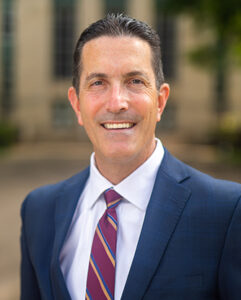President, University of Charleston

By Megan Bevins
Growing up, Marty Roth wasn’t sure what his future would hold. While he considered culinary school and played in a rock band, he ultimately decided to pursue a career in business.
The beginning of his workforce experience took place in the fields of catering and retail; however, Roth’s marketing professor from the University of Pittsburgh, Bill Sauer, inspired him to earn a master’s degree and pursue a career in academia. Roth says Sauer’s work-life balance and job flexibility were attractive.
While earning his doctoral degree, he started his first professional role as associate director at a market research firm. Once he earned his Ph.D., Roth began working as an assistant professor at Boston College (BC), the role that launched his career in higher education that has now spanned 30 years. He also met his wife, Lynn, at BC.
After his eight-year run at BC, he worked as a professor at the University of South Carolina (USC) for 16 years, performing many different administrative duties. He then served as dean of the business school at the University of Hartford (UH) for five years before beginning his current role as president of the University of Charleston (UC).
Aside from Sauer, Roth notes many other important mentors throughout his journey, including Hassell McClellan, a teacher and advisor at BC; Jeff Arpan and Joel Smith, who served as examples of great leadership while at USC; and Walter Harrison, the president of UH while Roth was there.
“Now in Charleston, I am blessed to have an outstanding board that provides encouragement and guidance to me and our leadership team,” Roth says.
Being around young people is one of the things Roth enjoys most about higher education. He continues to teach, which gives him an opportunity to mentor.
“Being welcoming and expressing curiosity in their interests and aspirations often leads to conversations that can lead to coaching and advising,” he says.
Roth explains that higher education is always facing challenges, particularly following the COVID-19 pandemic, as it forced those in the collegiate environment to rethink how to help students progress while keeping them safe.
“Developing that playbook on the fly was challenging,” he says. “However, by unifying our efforts and leveraging our collective assets, we navigated the crisis smoothly. Our faculty, staff and community health leaders all came together to face each obstacle that came our way.”
Despite any challenges, UC has seen great success under Roth’s leadership. Along with many program innovations, he has helped raise tens of millions of dollars for new academic programs, learning ventures and recreational spaces.
Some of these new amenities include health care simulation and virtual reality labs, as well as the Welch Athletic Complex, Downtown Innovation Hub, Outdoor Recreation Center, Outdoor Fitness Court and the upcoming Rehabilitation Science and Athletic Training Center, where graduate occupational and physical therapy programs will be housed.
“None of these accomplishments would have been possible without our incredible community of supporters,” Roth says. “It’s inspiring that so many share our vision to be Charleston’s university.”
Roth finds it important to give back by volunteering for the American Red Cross, Charleston Area Alliance, Clay Center for the Arts & Sciences and Rotary Club of Charleston, WV.
If an organization can benefit from his skills, has a mission that aligns with that of UC and shares core values which align with him and the university, Roth feels he should contribute.
“Everything good requires a clear vision, dedication and hard work,” he says. “If we want things to remain good and be better, we need to do our part.”
Roth holds a great love for the Mountain State, and one of his favorite activities is hosting events on his back lawn, as it provides a stunning view of the Kanawha River and state capitol. However, he feels the best thing about West Virginia is its people.
“West Virginians are so warm and welcoming. We have our challenges, but all places do. What’s most important is with whom you tackle them,” he says.








